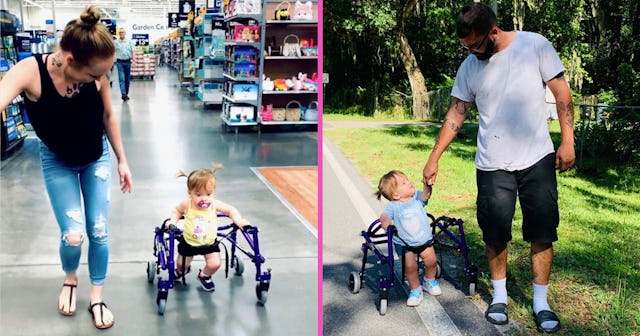Toddler Who Had Fetal Surgery For Spina Bifida Continues To Defy All Odds

Even just ten years ago, it would have been considered somewhat of a medical anomaly for a baby with a severe case of spina bifida to be born with the function of their legs. Because up until recently, paralysis for spina bifida patients, at least to some degree, was almost a guarantee among those born with severe cases of the condition. But thanks to an experimental fetal surgery, infants like the now-21-month-old Ava Reyes have been given the opportunity to defy all odds, proving that what was once said to be impossible was really just the start of a lifetime full of possibilities.
At just shy of two years old, the small, yet mighty Ava — who was diagnosed with the congenital defect during a 24-week anatomy scan — has already become one of the biggest success stories for a new type of fetal surgery that offers babies more mobility. Walking alongside her on this journey? Ava’s mother, Erika Reyes, a fierce influencer in the spina bifida world, who uses her daughter’s story to bring awareness to the condition and shed some light on the hope this surgery can bring.
Whereas the only treatment for spina bifida — a defect which causes part of the spinal cord to become exposed through a “gap” in the backbone — was once a surgery performed after birth, experts have learned that in-utero procedures are proving much more effective at boosting mobility and providing a better quality of life for patients. Finding the defect can be straightforward, but as the Reyes’ family learned, finding a physician who is up to date on the benefits of the surgery, as well as a fetal surgeon who is skilled enough to perform it successfully, is no easy feat.
Courtesy of Erika Reyes
When Reyes and her husband were first given their daughter’s diagnosis, the initial suggestions for treatment were to allow surgeons to perform surgery on Ava after she was born or to terminate the pregnancy. It wasn’t until Reyes’ nurse told them about the in-utero procedure that she or her husband even realized that there was another alternative out there with better outcomes than what had previously been recommended.
After consulting with a specialist and learning that Ava’s mobility could be improved by up to 50% with a successful procedure, the Reyes family decided to move forward with the surgery and began the rigorous screening process to see if they qualified. Two weeks later, Ava and Reyes went down in history as one of the first mother-child duos to undergo this type of fetal surgery for spina bifida at Winnie Palmer Hospital in Florida.
Courtesy of Erika Reyes
“They performed a C-section on me to get to Ava,” Reyes told Scary Mommy. “[The surgeon] went in my belly and grabbed Ava, flipped her over to her back, and she was actually missing skin on her back so they actually had to put a skin graft in when they were repairing her spine. And then they just sewed me back up, and she was still in my belly.”
Reyes said that every child’s healing will vary, but she is adamant that the procedure helped Ava. Just a month after the surgery, Ava was born — wiggling her toes nonetheless. And today, not even two years later, she continues to make great strides and exceed milestones which many have doubted possible up until the exponential growth of the world of fetal surgery.
Most recently, Ava has been learning how to master walking with her bright purple pediatric walker, and she’s even been taking a couple of steps on her own. Unlike the days when she was a bit younger, Reyes says that her walker is giving Ava the independence every little kid craves.
“One day she wanted to walk in the walker, and she just took off, and she never looked back,” Reyes told Scary Mommy.
If this sounds similar to your own experiences of having a newly-walking toddler in the home, don’t be surprised. Because beyond the miracle of Ava’s unique story and birth, what Reyes wants others to see is just what she does — a little girl who has the same heart, desires, wants, and needs as every other kid out there.
Courtesy of Erika Reyes
“I don’t think of my child as being special needs. I look at her, and I see my daughter,” she added. “She might need some extra help, but it’s worth it. I can’t picture myself not being a special needs mom.”
Despite the challenges it may present, parenting a child with special needs has become the Reyes’ family’s norm. For them to see Ava succeed in so many areas where it was once said that she would fail, only fuels Erika’s passion in the advocacy work she does to raise awareness for spina bifida.
“To see her walking after they said it was probably never going to happen, I mean, it’s definitely one of the best feelings in the world,” Reyes says.
For parents facing a spina bifida diagnosis, Reyes’ hope is that Ava’s story can be one of encouragement — that these mothers and fathers will take an active role in researching spina bifida carefully and personally before making an informed decision on how to best move forward.
Because when it comes to children with spina bifida, it is her belief that, despite the situation that plays out, “these kids… they’re happy.”
To walk with Ava and her family along this journey, follow Fight Like Ava on Facebook.
This article was originally published on